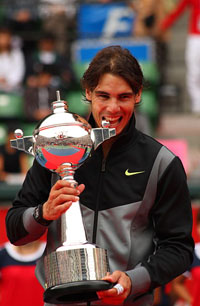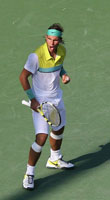 |
Born: 3 june 1986 Height: 185 cm (6 ft 1 in) Birthplace: Manacor, Mallorca, Spanien Residence: Manacor, Mallorca, Spanien Turned pro: 2001 Plays: Left-handed (two-handed backhand) Career prize money: $46,300,862 Career titles: 46 Grand Slam results Website: www.rafaelnadal.com |
Rafael “Rafa” Nadal Parera is a Spanish professional tennis player and a former World No. 1. As of 20 February 2012, he is ranked No. 2 by the Association of Tennis Professionals (ATP).
He is widely regarded as one of the greatest players of all time; his success on clay has earned him the nickname “The King of Clay”, and has prompted many experts to regard him as the greatest clay court player of all time.
Nadal has won ten Grand Slam singles titles, including six French Open titles, the 2008 Olympic gold medal in singles, a record 19 ATP World Tour Masters 1000 tournaments, and also was part of the Spain Davis Cup team that won the finals in 2004,2008, 2009 and 2011. He completed the career Grand Slam by winning the 2010 US Open, being the seventh player in history, and the youngest in the open era, to achieve it. He is the second male player to complete the Career Golden Slam (winner of the four grand slams and the Olympic Gold medal) after only Andre Agassi.
Nadal had a 32-match winning streak in 2008, starting at the 2008 Masters Series Hamburg to the 2008 Western & Southern Financial Group Masters and Women’s Open, which included titles at Hamburg, the French Open (where he did not drop a set), Queen’s Club, his first title at Wimbledon, and the Rogers Cup. In 2011, by winning the Monte Carlo Masters, he became the only player to have won seven editions of a tournament in a row at the ATP level. Nadal was ranked world No. 2, behind Roger Federer, for a record 160 consecutive weeks before earning the top spot, which he held from 18 August 2008 to 5 July 2009. He regained the world No.1 ranking on 7 June 2010, after winning his fifth French Open title. He held it until 3 July 2011, when Novak Djokovic replaced him as world No. 1. Nadal has held the No. 2 ranking for an ATP record 222 weeks (as of 13 February 2012).
Early and personal life
Rafael Nadal was born in Manacor, Majorca. Recognizing that Nadal had a natural talent for tennis, another uncle, Toni Nadal, a former professional tennis player, introduced him to tennis when he was three years old.
At age eight, Nadal won an under-12 regional tennis championship at a time when he was also a promising football player. This made Toni Nadal intensify training, and at that time he encouraged Nadal to play left-handed for a natural advantage on the tennis court, as he noticed Nadal played forehand shots with two hands. When Nadal was 12, he won the Spanish and European tennis titles in his age group and was playing tennis and football all the time. Nadal’s father made him choose between football and tennis so that his school work would not deteriorate entirely. Nadal said: “I chose tennis. Football had to stop straight away.”
When he was 14, the Spanish tennis federation requested that he leave Majorca and move to Barcelona to continue his tennis training. Nadal’s family turned down this request, partly because they feared it would hurt his education, but also because Toni said that “I don’t want to believe that you have to go to America, or other places to be a good athlete. You can do it from your home.” The decision to stay home meant that Nadal received less financial support from the federation; instead, Nadal’s father covered the costs. In May 2001, he defeated former Grand Slam champion Pat Cash in a clay-court exhibition match.
At 15, he turned pro. Nadal participated in two events on the ITF junior circuit. In 2002, at the age of 16, Nadal reached the semifinals of the Boy’s Singles tournament at Wimbledon, in his first ITF junior event.
By the age of 17, he beat Roger Federer the first time they played and became the youngest man to reach the third round at Wimbledon since Boris Becker. At 18, he helped pace Spain over the US in the junior Davis Cup in his second, and final, appearance on the ITF junior circuit. At 19, Nadal won the French Open the first time he played it, a feat not accomplished in Paris for more than 20 years. He eventually won it the first four times he played at Roland Garros. In 2003, he had won the ATP Newcomer of the Year Award. Early in his career, Nadal picked up the trademark habit of biting the trophies he won. (Source: http://en.wikipedia.org/wiki/Rafael_Nadal)
 |
 |
 |
Playing style
Nadal generally plays an aggressive, behind-the-baseline game founded on heavy topspin groundstrokes, consistency, speedy footwork and tenacious court coverage thus making him an aggressive counterpuncher.Known for his athleticism and speed around the court, Nadal is an excellent defender who hits well on the run, constructing winning plays from seemingly defensive positions. He also plays very fine dropshots, which work especially well because his heavy topspin often forces opponents to the back of the court. Nadal is primarily a baseliner, although he has been noted by several commentators (including John McEnroe) as an excellent volleyer, which has contributed to his reaching four Wimbledon finals on grass, winning two of them, and has been observed approaching the net more often since 2009.
Learn how to hit the 8 different backhand volleys – click here
In recent years, Nadal employs a full western grip forehand, often with a “lasso-whip” follow through, where his left arm hits through the ball and finishes above his left shoulder – as opposed to a more traditional finish across the body or around his opposite shoulder. Nadal’s forehand groundstroke form allows him to hit shots with heavy topspin – more so than many of his contemporaries. While Nadal’s shots tend to land short of the baseline, the characteristically high bounces his forehands achieve tend to mitigate the advantage an opponent would normally gain from capitalizing on a short ball. Although his forehand is based on heavy topspin, he can hit the ball deep and flat with a more orthodox follow through for clean winners. Professor Rolf Wirhed – The Anatomy & Biomechanics of the forehand stroke
Nadal’s serve was initially considered a weak point in his game, although his improvements in both first serve points won and break points saved since 2005, have allowed him to consistently compete for and win major titles on faster surfaces. Nadal relies on the consistency of his serve to gain a strategic advantage in points, rather than going for service winners. However, before the 2010 season, he altered his service motion, arriving in the trophy pose earlier and pulling the racket lower during the trophy pose. Before the 2010 U.S. Open, Nadal modified his service grip to a more continental one. These two changes in his serve have increased its average speed by around 10 mph, maxing out at 135 mph (217 km), allowing him to win more free points on his serve.
Do you wan´t to know how to hit a Kick Serve?
Nadal is a clay court specialist in the sense that he has been extremely successful on that surface. Since 2005, he won six times at Roland Garros, seven times at Monte Carlo and five at Rome. However, Nadal has shed that label due to his success on other surfaces, including holding Grand Slams simultaneously on grass, hard courts, and clay on two separate occasions, winning five Masters series titles on hardcourt, and winning the Olympic gold medal on hardcourt.Despite praise for Nadal’s talent and skill, some have questioned his longevity in the sport, citing his build and playing style as conducive to injury. Nadal himself has admitted to the physical toll hard courts place on ATP Tour players, calling for a reevaluated tour schedule featuring fewer hard court tournaments.
(Source: http://en.wikipedia.org/wiki/Rafael_Nadal)
http://youtu.be/tjjXi5tBZ7I
http://youtu.be/ZrW-sIREZow
